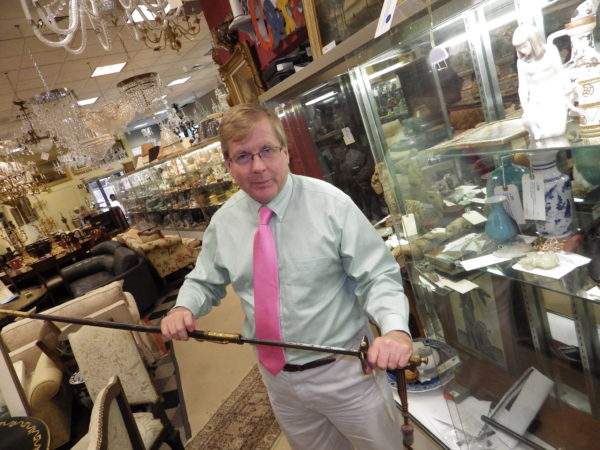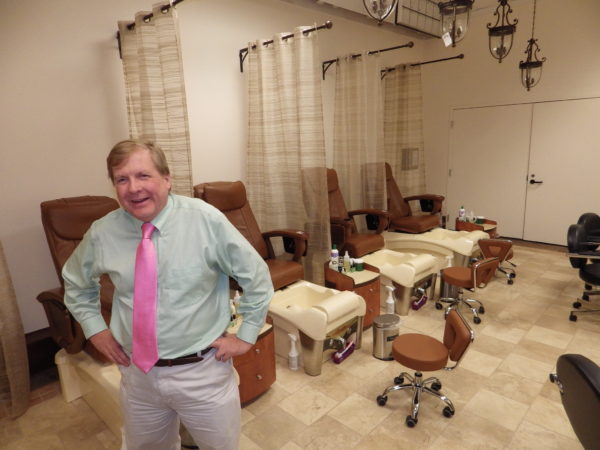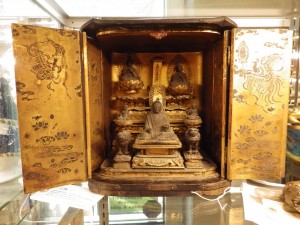Symbiosis Inc. — Greenwich Auction and Caché Nail Spa share the same roof

- David Johnson, principal, Stamford-based Greenwich Auction and Caché Nail Spa. Photo by Bill Fallon
By the end of August, the burgeoning national pastimes of spa pampering and shopping ”” seemingly oxygen itself for many ”” will find a home at the same 13,000-square-foot Stamford address, where until now the shopping arm has held sway exclusively in the form of art, jewelry and antiques. Should Czar Nicholas I rejoin the quick, his sword is there for sale, soon potentially coupled with a foot rub.
“Who doesn”™t like to have their feet massaged?” asked David Johnson, 56, whose vision to pair art and spa businesses is underpinned by engineering and business degrees and by decades in the global corporate marketplace.
Greenwich Auction at 83 Harvard Ave., which has doubled its sales every six months since reinvigorating its auction business two years ago and the coming Caché Nail Spa, will complement each other, said Johnson, principal of both businesses. If a spa/fine art mashup appears an odd business marriage, Johnson reassures it is not: The spa has repeat-visit leisure time built in and the art business complements that with browsing built in.
Johnson was already in the art business ”” primarily auction ”” when he began the search for a complementary business. A stated part of his business plan was that he could undercut the competition via location. A company flier says: “Easy I-95 access” ”” it is close to Exit 6 ”” “in Stamford”™s undiscovered area means 80 percent rent savings go into your pocket.”
Quality is evident at both ends of the split space. The spa has its own entry, but feeds into the art warehouse via a marble-floored hall. Besides an abundance of marble, the spa”™s floors and walls feature real walnut, not veneer. The idea has already yielded its first sale.
“We won”™t be open for another week or so,” Johnson said recently. “But a woman who came in for the spa and found it was not yet open walked up front and bought something.”
JohnsonӪs Bachelor of Science in engineering from Ohio State University led to work on the Minuteman nuclear missile for the U.S. Air Force and on early digital photography for Kodak. He later earned an MBA from the University of Dayton and worked executive stints across the U.S. and globally with food and beverage giants Kraft and Nestl̩ Waters.
“We did the spa research and we reverse engineered a spa business”™ profit-loss statement,” Johnson said, citing help from his wife, Gretchen, a New York City commuter who works full time in another business. “We had seen at our previous location by the passport office on Canal Street (in Stamford) that while waiting for their passports ”” sometimes three hours ”” people would shop. Actor Michael Douglas was getting his passport one day and, while he waited, he came in to shop.
“Cracker Barrel uses this model,” he said, claiming the Interstate-centric restaurant chain makes more money off its general store merchandise than off its food. “What”™s a business where people have to repeat their visits and where they have to wait? We did not want groceries or haircutting, so we decided on a spa.”
He explained the reverse engineering: “Here”™s their size. Get to know the neighborhood for the local demographic. Count the number of employees. Get their prices. Because we are already in business, we know a lot about insurance costs so we can figure that.”
The process has taken 18 months. The original plan to begin the spa sooner was delayed for six months by a glut of consigned pieces for the auction business. “So we waited until we had all our ducks in a row,” he said. “And you know what? You will never have all your ducks in a row. I”™m not sure that”™s possible.”
The move to open the spa has had a ripple effect down the hall behind the phalanxes of display cases. “We”™re looking for smaller pieces now, less furniture and fewer big pieces,” Johnson said. “Or we”™ll offer finger furniture: our term for furniture you take when you buy it.”
The business recently held an auction ”” it holds two per month ”” for which 1,663 people registered to bid (a requirement) and 112 cast bids. The company markets through direct mail and print and, most formidably, via email. It buys lists of up to 600,000 prospective auction participants in a marketing process that costs about $1,000. An equal number of postcards would cost the company $300,000, Johnson said. That July auction saw 656 items sold for a total $157,000. Buyers were from 10 different countries. “At the big New York auction houses, they have to get $5,000 per piece to conduct business,” he said. The average price for the July Greenwich Auction was about $240, short of the $300 typical price Johnson usually averages.
Estate sales are part of the auction business and Johnson has handled recent attention-getters featuring the belongings of filmmaker Ron Howard and philanthropist Mary Rockefeller. If negotiations pan out, the business will score a coup in the form of the estate of, as far as Johnson knows, the only U.S. Army Air Corps officer stationed in Iran in World War II, who remained there for decades and who collected art the entire time.
Johnson said stories and histories ”” a gift watch from Napoleon to his brother, a portable Buddhist prayer box, a handmade frame to rival the painting it holds ”” separate his pieces from those available at the box stores. “I”™ve always loved history and we consider ourselves stewards of history. Despite what some might think, we”™re not in the ”˜thing business.”™ We”™re in the entertainment business. These are for people who want to build a story around a piece.”
Johnson has merged direct-marketing efforts with nearby paint and home remodeling store Ring”™s End and Moore Physical Therapy. A just-sent-out oversize postcard may garner a 2 percent response, Johnson said, which is several times better than any of the stores might hope for mailing cards alone. And the cost was reduced from about $44,000 per store for the campaign to $11,000.
Greenwich Auction is by its nature a wholesale business, said Johnson, who is also an auctioneer. It forms the foundation of the business, dating to 11 years ago when it was on Canal Street. That facility burned down ””flowed by a six-year successful legal struggle to recoup losses for the company and for the more than 100 dealers who had art on the premises at the time flames broke out.
The business has been and will remain an auction house. The art takes up 9,000 square feet and the spa the remaining 4,000 square feet.
“We determined after the fire that whenever we got our feet back on the ground we were going to be in the auction business,” he said. “That was the original premise.”
Art auctions appealed to Johnson because, “There”™s fast action. You can grow faster. It”™s interesting. You get to interact with more people and you don”™t have to dust anything. It comes in and goes out.” He said his business model calls for the spa to supply 25 percent of income and, in turn, to fuel upped retail offerings to account for another 25 percent and the auction business 50 percent.
Johnson related that a friend questioned the curious coupling of art purchases, plus other things like vintage clothing and a stadium”™s worth of lighting fixtures, and a spa. “Our low rent will undercut the competition,” he said, citing three customers per hour required for the effort to break even. “If you work your business plan beforehand, it”™ll work for you,” he said. “A friend who said it would never work heard about our first sale ”” even before the spa was open ”” and said, ”˜Oh my gosh ”” this might actually work.”™”

